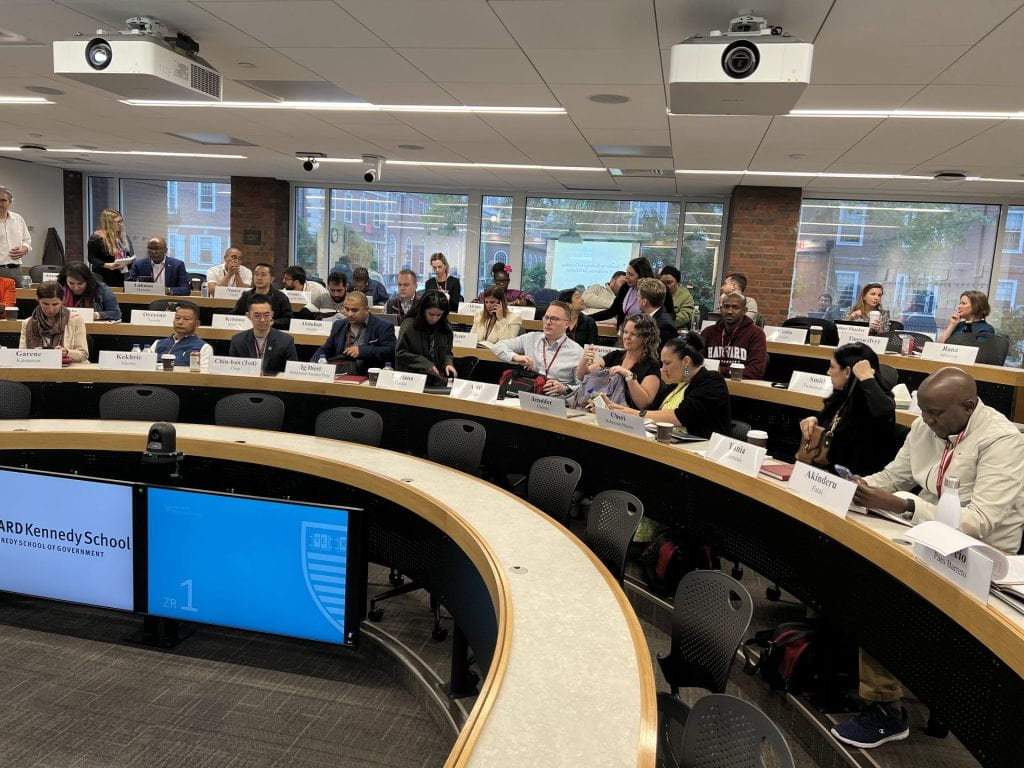Guest blog by Antti Leino, IPP’23
When presented with the opportunity to take the Harvard IPP program in the spring of 2023, I was a bit hesitant at first as my workload was substantial. But I also saw it as a chance to evaluate and view my day-to-day job from a wider angle, maybe even learn something and improve my productivity.
The problem I had with the IPP program is that my role at the city executive office is not concentrated on a single issue, problem or even sector, but instead the oversight of the operations of the whole city. I work as a political advisor to the Mayor of Helsinki and have held the position since the beginning of this municipal election term from the beginning of August 2021. My role also consists of the role of acting as a chief of staff to the mayors’ cabinet consisting of 10 people. It can be argued, my position is a role where I can potentially make a change of (at least some) things. Similar to Jay-Z, I would say that I have 99 problems and not enough time for one.
Helsinki is the capital and largest city in Finland. Helsinki, like many growing cities, faces challenges in integrating a diverse and increasing immigrant population, which can impact social cohesion and cultural integration. At the same time, the city is grappling with rising economic disparities, marked by an increasing wealth gap and significant differences in wealth accumulation across different demographics.
Background of the problem
By the end of 2023, City of Helsinki had around 670,000 residents. The Helsinki metropolitan area consists of 1.2 million people. In terms of management and administration, what makes Helsinki especially large in comparison, is the amount of people it employs, 38,000. This is because in Finnish public sector, all education before tertiary education is managed by the city and all healthcare except the specialized health (complex surgeries and such) is also managed at city level. As a comparison, I visited Quebec City with the Mayor in November 2023, which is a somewhat same sized city in Canada and despite that it has 550,000 inhabitants, it only has under 10,000 people on the city payroll.
After the collapse of the neighboring Soviet Union, since the 1990s, Finland has seen a significant increase in its immigrant population. Helsinki, as the capital city, is a primary destination for many of these immigrants. Even though Finnish immigration policy in the case of refugees tries to distribute refugees to reception centers around the country, usually the same happens as in any other country, that immigrants will move to larger population centers.
Attracting foreign labor is a relatively new thing in Finland. Politicians have generally been more worried about the domestic unemployment rather than attracting immigrants. We are now in a situation, where we have relatively high unemployment rate combined with a lack of suitable workforce in many sectors.
Finland is waking up to the aging population problem late. Finland is facing a demographic dilemma with an aging population and is now making efforts to attract skilled immigrant workers. The problem for Finland is, that in comparison it is not that attractive for foreign labor. Despite high living standards and a reputation for quality of life and even being in the top of international happiness indexes, Finland faces hurdles in attracting immigrants due to factors like high living costs, taxation, cold and dark winters, and a complex language. Additionally, there’s a notable anti-immigrant sentiment and a reluctance to employ foreigners. This is compounded by a friction to recognize overseas qualifications and a perceived bias against non-Finnish applicants in the labor market. Even though I am born and raised in Finland, I have experienced some doubts by employers because I went to university in the UK. Even though the universities I graduated from fare far better in international rankings than Finnish Universities.
It should be noted at that this point, immigration is not the same thing as accepting refugees. It is just so that for a long-time, immigrants in Finland have been mainly seen as refugees and those that have come to work here are an exception of sorts in people’s minds.
My biggest learning from this course might sound simple, but throughout my career I have been involved in situation where I have had to create a solution for a problem. This course gave me confidence to question that approach completely, as it is not about the solution but about the problem itself. Though I do not believe saying: ”I went to Harvard to be able to say back to you, are you sure that is the problem”, might not be the best approach.
Back to the problem. Initially (and in application) my problem was supposed to be about budgeting practices of the city, but during the time in Boston, I decided to change it to something more comprehensive and harder. I finally decided on the problem “Increasing socio-spatial segregation among youth and children in Helsinki”.
“Socio-spatial segregation”, also known as urban segregation, is generally seen as an undesirable division within a city based on socio-economic and ethnic lines. This division often leads to the concentration of disadvantaged people and social problems in certain areas. It can negatively impact the well-being and life opportunities of residents in these areas. This includes things like stigmatization, negative social influences, and a decrease in educational outcomes. On the other hand, areas with more affluent residents tend to become increasingly separated from these disadvantaged areas.
As I stated earlier, city has quite a large responsibility over public services in terms of tackling segregation.
In the summer of 2022, the mayor started 4 main strategic programs to accelerate the city’s 4-year strategy “Place of Growth”. These groups are Increasing productivity, tackling climate change, creating a pleasant city, and prevention of segregation.
The mayor gave me the prevention of segregation to oversee. In the spring of 2023 (at the same time I started the IPP course) the strategical group finished a white paper on the current situation of segregation in Helsinki (unfortunately completely in Finnish, but google translate works). It is the most up-to-date analysis of the segregation situation in Helsinki. The most growing concern is the increasing urban segregation among children, especially between native and immigrant children. That’s the problem I chose.


The solution?
After returning from Boston, I made sure my problem is a problem for the people directing that sector at the city’s management, mainly at the education division. The easiest part of my PDIA work was the authorization, as the mayor is pretty much the top authorizer for things. The question about segregation became one of the main topics at the city leadership seminar held in the end of September. Everyone agrees that the socio-spatial segregation among children is a problem, but what should be done, it is the real challenge.
The interesting part is what I did after this: In August when we brainstormed and derived our team (Mayors cabinet) priorities for the upcoming autumn, I gave the City’s strategic cross-divisional segregation working group for my subordinate to oversee. In terms of how traditional management over an issue is usually done, I pretty much gave my problem away. Now this was something of a contrary to the traditional plan & control approach of how to solve a problem. The first step is usually to take complete ownership of it, direct and be at least the chair of the board so to speak in solving it. I thought, after me being on top of the city strategy creation and implementation since the autumn of 2021 and overseeing the creation of the segregation paper mentioned and linked above, it was time for new approach and new people.
Was this laziness? I thought a lot about this. I kind of saw myself becoming a bottle neck.
“One of the most important lessons I have learned in this course, is that leadership is not about doing everything myself. Delegation is hard and it is something that leaders should not be afraid of, even if it might signal giving up power. I rather delegate and give up power rather than become the bottleneck and in a worst-case scenario have a burn-out. This is probably the best for the organization as well.”
What school, parents, and society (at least try to) teach you for your whole life is that you must have confidence to take personal responsibility of hard issues. I find this traditional advice might be good in expert and analyst -positions, but in direct contradiction when it comes to good leadership. Taking responsibility is not the same as doing it all by yourself.
With new administrative leadership and fresh minds in charge, the strategic segregation working group has been able to streamline its main priorities for the rest of the election term. The working group now consists of the city core leadership as all division managers (education, environment, health care, culture, and leisure) are now part of it. Enabling coordination across divisional lines.
At the time of writing this text as a summary of my experience with the IPP program, the city budget negotiations ended two weeks ago. The mayor was able to implement an extra 4 million euros positive discrimination package, with a target (simply said) to employ the best teachers to the worst schools. It is peanuts in the city budget, and we have had some positive discrimination related packages before, but this is a first politically made add on to this specific segregation prevention purpose. But this is only a start.
What makes for good policy implementation?
From my experience with the IPP program and throughout the work I have done at the City, I have learned that if we want to establish something permanent, extra budgeting alone is not enough if we want to create something that lasts. In public policy making and budgeting, what usually happens is that when someone comes up with something new idea or a project, it always requires money. This is also what politicians suggest and demand.
It is in the very core of plan & control related projects, to try to implement something by creating an external program over the top of other programs and working groups. This is what the City does a lot. But if we want permanent policy change and we must tackle an issue we have not seen before, a simple project or extra allocation of resources is not enough.
What is required is a change in culture and a shift in our core modus operandi. If (and when) the prevention of socio-spatial segregation among children is one of the core strategic goals of the city administration, it’s prevention must be taken into account in all core day-to-day operations and in every decision from bottom up, not only as a top-down solution with a yearly budget.
Implementing a new permanent public policy should never be an extra project, but it needs to fit into our core activities. Implementation of policy is successful, when it is considered on every aspect of city’s/governments’ public policy planning. The work on this continues.
This is a blog series written by the alumni of the Implementing Public Policy Executive Education Program at the Harvard Kennedy School. 47 Participants successfully completed this 7-month hybrid program in December 2023. These are their learning journey stories.
